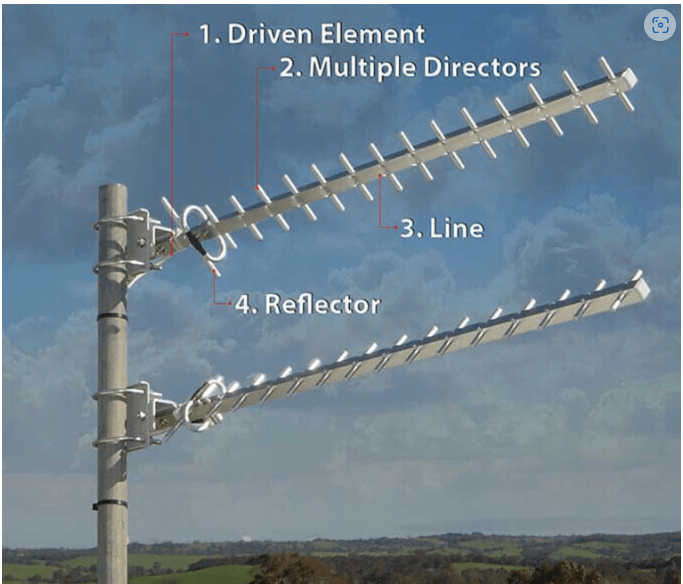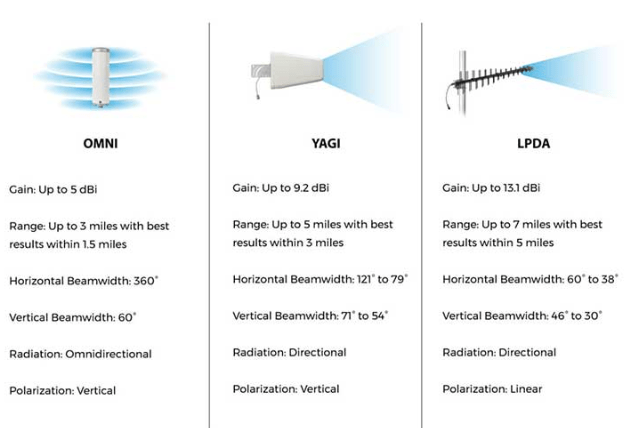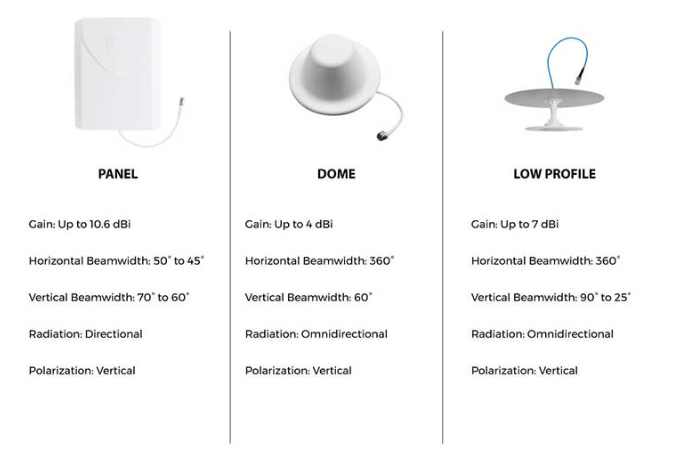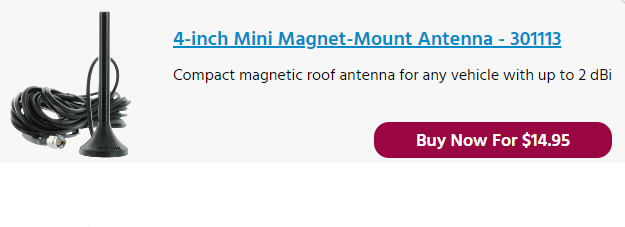- US Based Customer Support
- Free Shipping
- Up to 90 Day Money Back Guarantee
THE COMPLETE GUIDE FOR THE CELLULAR ANTENNA: DISCUSSION OF VEHICLE, OUTDOOR, AND INTERIOR ANTENNAS

Written by Sadia Jahangir
28th Nov 2022
How a Signal Booster System's Power Is Affected by Cellular Antennas
Since cellular antennas are two of the three essential components of a signal booster system, you can expect them to have an impact on the system’s power and performance. The right set of antennas can be just as important as choosing the right booster because each antenna adds a different component to the equation.
WE FIX POOR CELL PHONE SIGNAL! FIND THE RIGHT SIGNAL BOOSTER FOR YOU:
The output power of your signal booster system is determined by five factors that are within your control:
- Gain of outdoor antenna
- Cable run loss between outdoor antenna and signal amplifier
- Gain of signal amplifier
- Cable run loss between the signal amplifier and indoor antenna
- Gain of indoor antenna
Even though the amplifier will do most of the heavy lifting, the right cellular antennas can give your system some serious kick. In circumstances where your signal is weak, this can be especially helpful.
How to Use an Outdoor Cellular Antenna and What It Does
An outdoor cellular antenna, also known as a “donor” antenna, attaches to a “cellular signal booster” to boost the signal. A 4G cellular antenna can capture any signal in its radiation pattern between the 698-2700 MHz range (specifically the 698-960 MHz and 1710-2700 MHz ranges). These antennas are typically wideband.
Donor antennas are typically the most challenging to set up correctly and are the first major component of a signal booster system. This is because of a number of things:
- For optimal performance, they must be positioned in an area with the strongest cell signal. Typically, this is located on the building’s roof.
- Many necessitate precise aim. This only applies to directional antennas, and Yagi’s are easier to aim than LPDAs. They must be aimed at a nearby cell tower.
- They require appropriate cabling, and that cabling must connect your signal amplifier inside.
The second step will differ depending on the kind of outdoor antenna you have, but the first and third steps above apply to all of them.
Yagi Antennas: The Old Reliable
The Japanese inventors Shintaro Uda and Hidetsugu Yagi created the Yagi antenna, also known as a Yagi-Uda antenna, in 1926. They have been a major contributor to RF transmission all over the world ever since. One of the most common uses for a Yagi antenna is to improve the cellular signal, and this article will focus specifically on cellular Yagi antennas. An interesting article on the history of Yagi-Uda antennas can be found here. If not, let’s get started.
What exactly is a Yagi Antenna?
A Yagi antenna is a directional antenna that improves radiation in a single direction. This radiation can be energy that is transmitted or received, like a cell signal, and it can be improved by a Yagi antenna.
What is the Purpose of a Yagi Antenna?
Yagi receiving wires have various purposes. They can be used in ham radio or radars to detect movement in the industrial setting. At the consumer level, they can be used to improve Over-The-Air television reception, and cellular Yagi antennas can now improve cell signal at home or at work in areas where telecommunications quality is difficult to guarantee. However, we do not recommend using them to improve your vehicle’s cell signal. We’ll tell you why in a minute.
How is a Yagi Antenna Operational?
The four main components that make up a Yagi antenna work together to make it work:
Motivated Part: The location where the feed line connects the transmitter and the Yagi to carry out the power transfer from the transmitter to the antenna is known as the driven element of a Yagi.
Director(s): utilized to provide directional power and gain to the antenna.
Line: The spine of the antenna connected to the driven element and held the directors and reflectors.
Reflector: Used as a mirror to reflect light, it rejects signals outside its range and amplifies those insides.
Yagi antennas can have a higher gain than omnidirectional antennas thanks to these components.
They don’t do well in a car because driving or sailing requires constant direction changes. Nonetheless, the directional idea of a Yagi makes it ideal for home and business establishments, as it takes into consideration more prominent increase and reaches.

Is a Yagi Antenna Oriented?
Yes. To be precise, a Yagi antenna is unidirectional, which is essential for increasing cell signal: Its goal is to maximize signal reception in just one direction from a specific carrier.
How Much Distance Can a Yagi Antenna Go?
A typical Yagi can be used up to 5 miles, but it usually works best up to about 3. Depending on the use case of your system (commercial or consumer use), Yagi antennas come in either 50 or 75-ohm configurations for amplifying cell signals. Because they are frequency-specific, operate with one or two carriers, and can be positioned to reach the best signal possible wherever you are, Yagi antennas are three times more powerful than omnidirectional antennas.

How Should I Target a Yagi Antenna?
A Yagi antenna will not receive any signal that is outside of the direction that it points to, so you should aim the outdoor antenna in the direction that best receives the signal from your carrier. To put it another way, you won’t get the boost you want if your carrier is out of the antenna’s beam. Before pointing your Yagi antenna, we therefore recommend locating the closest cell tower.
Antennas in both directions: The Easy Setup
Omnidirectional (or Omni) cell receiving wires pull in signals from all bearings. In low-lying areas or on the sides of commercial buildings, you’ll often see cellular omnidirectional antennas. Although omnidirectional antennas are available for all RF types, this article will concentrate on cellular.
What is the Purpose of an Omnidirectional Antenna?
For multi-carrier setups, omnidirectional antennas are the most useful and easiest to install than other outdoor options. They collect every signal in a given area. This has a few benefits as well as a few drawbacks.

Omnidirectional antennas have three main advantages:
- Easy to install
- will amplify all cell signals in your area from multiple carriers and cell towers in multiple locations
- It is excellent in areas with strong signals and valleys with low elevation.
However, in comparison to Yagi and LPDA antennas, they also have a few drawbacks:
- Not optimized for rural areas where the distance from the cell tower is the main problem
- Don’t reach as far as a directional antenna
- Don’t give your incoming signal as much gain as a directional antenna. Susceptible to “signal noise” and can become overwhelmed in extremely busy urban areas.
Omnidirectional antennas also have some physical limitations that should be taken into consideration.
However, when paired with a powerful amplifier, omnidirectional antennas are well-equipped to perform admirably in signal areas of strong to moderate strength.
Antenna for the Cellular Log-Periodic Dipole Array (LPDA): The Most Powerful
There are many names for log-periodic antennas: LPDA, which stands for log-periodic dipole array, is also known as a log-periodic aerial, a log-periodic dipole antenna, or simply a log-periodic array. Their job is straightforward: to function over a large frequency range. The bandwidths of these frequencies vary depending on the type of log periodic antenna you purchase.
They occur more frequently than you might expect. Over the course of your life, you’ve probably passed log periodic antennas perched on rural and suburban rooftops and protruding from apartment balconies. Log periodic antennas have always been used for analog television, which was the most common style until digital took over and took its place in recent years. Indeed, even still, they stay utilized in numerous areas, and, as a fast quest for a television receiving wire will show you, they keep on ruling that market.
The justification for this is straightforward: They can cover a wide range of broadband frequencies and have a great range. They have more power than their brethren due to their directivity, which enables them to have a narrower focus than their cousins, the Yagi antenna. They can operate in areas that Yagi’s cannot, provided they are installed correctly.
What are the workings of LDPA (Log Periodic Dipole Array) antennas?
Half-wave dipole elements are typically used in log periodic antennas, which are also referred to as “LPDAs” or “LPDAs.” Each half-wave dipole element consists of two metal rods that are positioned along a support boom that lies along the axis of the antenna. The spacing between these components makes it possible to fine-tune the LPDA’s frequency range, which means that cellular LPDAs are tuned to pick up cellular frequencies between 698 and 2700 MHz, VHF, UHF, Wi-Fi, and other high-frequency GHz wavelengths are the primary focus of other LPDA antennas.

EMC antennas, which operate electromagnetically, and array antennas, which are large, complicated arrays of numerous antennas that can both transmit and receive, are contrasted with LPDA antennas. LPDAs can operate on standard power and can be installed almost anywhere at a reasonable cost, making their applications significantly more diverse.
Antenna gain, measured in dBi(not published), is the primary focus of LPDA antennas. The LPDA can function effectively in fringe conditions, whereas a Yagi or omni antenna focuses on bringing signal into relatively close surroundings. At a beam width of approximately 30 degrees, this is accomplished with a relatively focused radiation pattern.
A three-element Yagi antenna can produce a radiation pattern with such a high gain and wide bandwidth. The feedline is electrically connected to these, which are referred to as driven elements. This feedline, which is typically twin-lead or ladder line but can also be coaxial cable, zigzags between the dipole elements. Due to the fact that the feedline itself replaces the dipoles in some LPDAs, these devices are referred to as log-periodic zig zag antennas.
Omni vs. LPDA vs. Yagi: Which is the best cellular antenna for me?
As previously mentioned, the three primary cellular antennas—Yagi, Omni, and LPDAs—have a few significant differences.
How Similar They Are
Omnidirectional antennas, Yagi antennas, and LPDAs pull in existing cellular signal (5G, 5G E, 4G, and LTE, depending on the bandwidths covered by the antenna). All of them increase the power of the signal upon pulling it in, but the extent to which that happens varies depending on the type.
How They Vary
The most prevalent type of antenna is an Omni. They don’t make any distinctions when they pick up signals across a 360-degree field. Regardless of whether you want them to, they will take any cellular signal that is out there. Since you can easily switch between multiple carriers at once, this is great if you have multiple cell sites nearby. Almost always, omnidirectional antennas have the appearance of rod-shaped cylinders. An Omni antenna is like the one you might have on your car’s radio.
Power is the primary drawback of an Omni antenna. Both its range and overall dBi gain are lower than those of directional antennas due to its 360-degree radiation pattern.
However, this drawback has some very real advantages: For multi-carrier setups in strong outside signal environments, Omni antennas are ideal. Omni antennas are preferred by a lot of our corporate clients because they typically need to serve multiple carriers (AT&T, Verizon, T-Mobile, etc.).inside of their structures.
Although it is possible for two T-Mobile or other same-carrier towers to be sufficiently close to one another for the Omni-antenna to receive a signal from both, this is probably extremely uncommon. You will most likely be close to one of each carrier tower, depending on where you are (for example, one AT&T tower, one T-Mobile tower, one Verizon tower, etc.), not three T-Mobile towers, one Verizon tower, or two AT&T towers, etc.).
An LPDA or Yagi antenna can help with that. These are more specific, with Yagi receiving wires being more broad use than LPDAs. Since the LPDA is more directional than the Yagi, their directionality enables them to have a greater gain and a longer range. Because of this directionality, a signal that reaches your amplifier can be more precise and powerful.
You’ll need to think more in the right direction the further away you are. On the other hand, becoming more directional can also help if you are in a very urban area and are constantly bombarded with signals that aren’t relevant to your situation.

Which of the outdoor antennas has the greatest gain?
In almost all circumstances, log-periodic dipole array (LPDA) antennas offer the highest gain. Although they are more difficult to aim and very directional, LPDA antennas have a longer range and a higher gain than Yagi and omnidirectional antennas. However, in rural or signal-poor areas, these are by far the best option.
The most effective method to Utilize an Indoor Cell Radio wire and What It Does
The component that broadcasts the cellular signal captured by outdoor antennas in buildings is known as an indoor cellular antenna. They are available in two styles, just like outdoor antennas: dome and panel
The shape of panel and dome antennas, which influences their operation, gives them their names. An omnidirectional antenna is one in which the boosted signal can be transmitted in all directions due to the dome’s shape. A directional antenna, a panel antenna only transmits signals in one direction.
These should go where you want the most signal. Your signal will be stronger the closer you are to the indoor antenna’s radiation pattern. Your signal booster system’s coverage area is directly impacted by this.
Board Receiving wires: Flexibility and Strength
The component that broadcasts the cellular signal captured by outdoor antennas in buildings is known as an indoor cellular antenna. They are available in two styles, just like outdoor antennas: dome and panel
The shape of panel and dome antennas, which influences their operation, gives them their names. An omnidirectional antenna is one in which the boosted signal can be transmitted in all directions due to the dome’s shape. A directional antenna, a panel antenna only transmits signals in one direction.
These should go where you want the most signal. Your signal will be stronger the closer you are to the indoor antenna’s radiation pattern. Your signal booster system’s coverage area is directly impacted by this.
Board Receiving wires: Flexibility and Strength
Panel antennas are utilized in the majority of Wilson Electronics’ weBoost signal booster kits. They are wall-mounted and send signals in a 45- to 70-degree directional cone. With such a narrow focus, the signal at the source can be stronger (the signal is better the closer it is to the panel antenna).
They provide 75 feet of coverage on average. This varies based on the strength of the external signal. There will be more coverage if the signal is strong outside. There will be fewer weak signal areas.
Due to inside interference and their higher gain, panel antennas are typically recommended first. Metal, concrete, and energy-efficient barriers, among other building materials, can prevent signals from entering the structure. Once inside, a signal booster, thick walls, and RF-disrupting materials like metal, glass, sheetrock, and so on, can also interfere with the signal from the inside antenna.

You can focus the signal in a specific area of your home or commercial building that requires a better signal with a panel antenna, such as your living room, home office, or conference room. As a result, there will be very little interference to the signal that is being broadcast in that area. Before the signal reaches lower-priority areas, better signals and faster data will be received by every device in that room first.
The panel antenna can be installed right side up or upside down on a wall or, in some cases, on a high ceiling to improve signal in rooms with limited or no coverage. Due to its beam width and strength, it can also improve signal in lower levels of your home or commercial building if installed on the ceiling. However, because the building materials it must travel through interfere with the signal’s strength, the signal won’t be as strong in the lower levels as it is in the room where the antenna is located.
Dome antennas are suspended from the ceiling and project amplified signals in a spherical, 360-degree horizontal beam. In order to transmit an identification signal in all directions, this provides a wide horizontal coverage spread.
With a dome antenna, you should be able to cover about 50 feet on average, depending on how strong your outside signal is. There will probably be significantly less coverage in areas with poor cellular service.
Keep in mind that proper installation of a dome antenna will necessitate access to an attic or crawl space. Subsequently, they will generally be better for business use, one-story homes, or staggered homes with drop roofs.

Dome antennas are fantastic at broadcasting improved (not publish) 4G, LTE, and 5G signals in large areas when installed under ideal conditions, which include low ceilings and zero to minimal interior interference.
A dome antenna, on the other hand, is not recommended if you have thick walls and high ceilings (usually 20 to 30 feet or higher), as the signal will weaken as it travels further.
Gain from Panel and Dome Antennas
A certain amount of gain, expressed in decibels (dB), is associated with each kind of antenna. Basically, gain addresses a radio wire’s capacity to coordinate the transmission it’s communicating and the way in which far the transmission can travel. High-gain antennas typically have a wider range because they are more directional. However, this is not always the case with antennas with lower gain. This is covered in the section on outdoor antennas.
Because they are directional, panel antennas will have more gain and reach than dome antennas. Our regular dome antennas (not published)have a gain of up to +5.1 dB, our low-profile dome antennas (not published)have a gain of up to +6 or +7 dB, and our panel antennas (not published)typically have a gain of up to +7.6 dB or up to +10.6 db.
An antenna with a higher gain will probably be your best option if you live in an area with poor reception. Compared to a dome antenna, this will make it possible for the broadcasted signal to be slightly stronger and travel slightly further inside your home or commercial building.
Dome versus panel: Which ought to I buy?
When deciding between dome and panel antennas, consider the following factors:
- The shape of the area where you want to boost the signal;
- The amount of inside interference in the area;
- The priority of coverage in that area.
Do you have a lot of inside interference around your home or building, such as thick walls, metal, and glass? Do you want priority services in a particular area, like a closed-off room or corridor? Choose a panel antenna if you answered “yes” to any of those questions.
Do you have open areas with few walls, no walls at all, or little interference from the inside? Do you want to spread the signal equally throughout your house or building? Do you have access to an attic or crawl space and low ceilings? If so, select a dome antenna.
One antenna may not be sufficient to provide the desired coverage, particularly in multi-level residential or commercial buildings, depending on the strength of your outside signal and the size of your building. Splitters (not published) and a combination of panel and dome antennas might be something to think about if you want to cover as much of your area as possible. If you decide to buy more antennas, make sure that their impedance rating of 50 or 75 Ohms is the same as that of your signal booster. If not, you’ll need more connectors and adapters and experience more loss.

Other Kinds of Indoor Antennas
There are a variety of indoor antennas available, including dome and panel antennas; They are simply the most prevalent. The weBoost Home Studio and the weBoost Home Room are two additional kinds of indoor antennas that can be used in conjunction with booster systems that are made to cover one to two rooms.
- Terminal antennas or whip antennas: Similar to the rubber ducky antenna on a Wi-Fi router, terminal antennas or whip antennas connect directly to the signal amplifier. Although not as powerful, they are omnidirectional like the dome antenna.
- Desktop antennas: The design of desktop antennas is nice and discrete. They can be positioned on any flat surface and are omnidirectional, enhancing signal strength wherever it is most needed. Even vehicles can make use of them!
How to Avoid Inter-Cellular Antenna Signal Oscillation
One of the most common responses to the question, “What is oscillation?” Why is my cell signal booster failing to function?”

Your two antennas are in a feedback loop because they are installed too close to one another.
Consider a microphone and a speaker. An unpleasant humming sound is produced when the microphone is brought too close to a speaker, and the closer they are together, the louder the screech becomes. This is called oscillation, and it also happens to your antennas.
Increasing the distance between the three parts of your signal booster will solve this issue. To prevent oscillation, your antennas should be spaced at least 20 feet apart vertically and 50 feet apart horizontally. Unfortunately, in order to eliminate the oscillation, you may need to relocate one or both of your antennas to a slightly less optimal position if you have your antennas set up as intended. However, the fact that the broadcast antenna might not always be in the best position is compensated for by the fact that the booster’s performance will significantly improve.
How to Avoid Overloading the Signal Booster
The majority of consumer boosters are susceptible to overload. If you use high-gain antennas and cable, have a good outdoor signal but a bad indoor signal, and bought a cheaper signal booster, you might be sending too much signal to your booster and overloading it. This makes the supporter shut down totally, to save itself.
Fortunately, there are a number of ways to fix this, and it is very simple.
We sell attenuators to prevent overload and slightly reduce the amount of signal you are bringing in if you want to throw money at the issue and solve it quickly. There are also boosters of a commercial grade that automatically reduce the strength of the signal you are receiving; however, these devices have a rather high price tag and are too much for most home setups.
You will need to relocate your antenna to a different location if you do not want to spend any more money. This can be done in one of two ways: turning it away from a signal that is too strong or placing it in a location with a signal that is weaker than yours will attenuate the signal. If you don’t mind going back up on the roof, this is the simplest and cheapest method.
How do I use a vehicle-mounted cellular antenna?
It’s possible to think of vehicle antennas as smaller, more portable versions of indoor and outdoor antennas. Since vehicles are prone to movement and will need to continuously broadcast and downlink cellular signals, the most significant distinction is that every outdoor vehicle antenna is omnidirectional. As a result, the size and power of vehicle outdoor antennas are what distinguish them from one another.
Antennas with a Magnet Mount: Simple to Use and Install

The magnet mount antenna is merely a small antenna that can be attached magnetically to a vehicle’s frame. Unless you have an aluminum frame, they are the easiest to install and offer little gain. Although it is possible to use a magnet mount antenna on any vehicle, it sometimes has trouble covering larger interiors.
The standard in-vehicle signal booster kits include the 4″ magnet mount, which is the most common magnet mount antenna. Additionally available are 12″ magnet mounts, which offer a little bit more gain over the typical cellular bandwidths. These are reasonable redesigns and ought to be considered by any individual who is having issues covering the lodge of their vehicle with a strong vehicle promoter like the weBoost Drive Reach.
Antennas for the Road (OTR): Large Cabins and Trucks

A mounted antenna known as an “Over-the-Road Antenna” is intended for use in RVs and semi-trucks, but it can also be used in pickup trucks or large SUVs. While they are more difficult to install than a magnet mount, these are significantly larger and more powerful. An OTR antenna can be a very good investment if you travel a lot or have a large cabin or interior.
There is not much more to say here: An omnidirectional vehicle antenna with more power is called an OTR. An OTR will be of assistance to you if your vehicle is large enough to warrant it, you spend a lot of time in it outside of urban areas, or you are not getting the boost you need from a magnet mount and a powerful mobile booster.
NMO Receiving wires: Installations for commercial fleet vehicles that are permanent

In the vehicle industry, “NMO” (New Motorola Mount) antennas are a bit of an odd duck. They are permanently installed in a fleet vehicle, such as a taxicab, delivery van, or semi-truck, for cellular purposes to achieve greater gain than a magnet mount. These are truly significant for organizations that depend intensely on their armadas.
In the event that you have a progression of armada vehicles, call us at 1-281-616-5786 and we’ll figure you out.
OTR vs. NMO: Magnet Mount vs. Which is the best mobile antenna for my vehicle?
Compared to building antennas, this is a simpler option.
Cars: 4” magnet mounts are sufficient for most cars. Upgrade: 12” magnet mount
SUVs: 4” magnet mounts work on most SUVs. Upgrade: 12” magnet mount or OTR
Pickup: 4” magnet mounts work on most pickups. Upgrade: 12” magnet mount or OTR
RVs: OTR. 4” magnet mount will work in a pinch.
Semi-trucks: OTR. 12” magnet mount will work in a pinch.
Fleet vehicles of any type: NMO. OTRs will work as an alternative
Cellular antennas for various vehicle types
There are a few additional kinds of vehicle antennas to discuss, but their applications are simpler:
- Large, waterproof marine antennas are intended for use on…well, marine vehicles. They can be used to make sure that a boat’s cabin has cell service up to a few miles offshore. If you own a boat, invest in one of these.
- The majority of multi-user kits include low-profile antennas, making them the most common type of vehicle interior antenna. They are designed to transmit directionally and not stand out, like candy bars.
- Desktop Antennas are small interior antennas that are best used in RVs or other vehicles with very big cabins. They have a higher gain but are harder to place than low-profile antennas.
Most Commonly Asked Questions
Are antennas better served by higher dBi?
Yes, generally. However, there are a number of good reasons to consider lowering the dBi level: the ease with which it can be installed, including multiple carriers in your network, the total cost, and whether or not your booster is likely to overload due to an excessive amount of incoming signal.
There has been some discussion of 5G cellular antennas. What distinguishes them from a 4G cellular antenna?
The T-Mobile 5G band is typically added to a “5G” antenna, extending its range to 600-2700 MHz. These have no effect on Verizon or AT&T 5G, which uses millimeter waves rather than cellular bands to broadcast. On the T-Mobile 5G network, they can therefore be used with signal boosters that are compatible with 5G.











